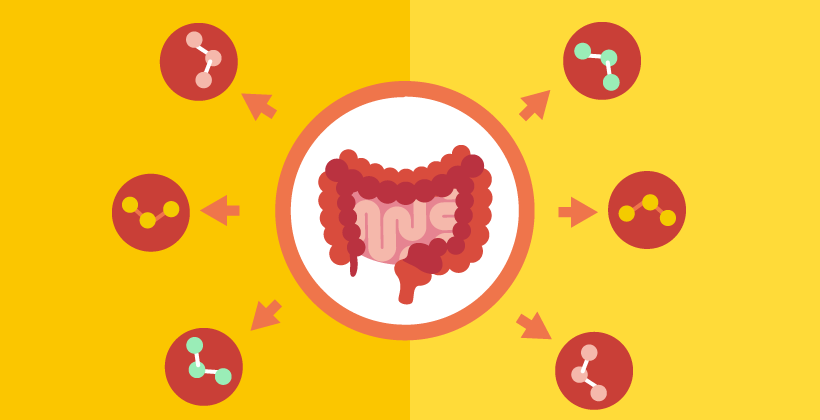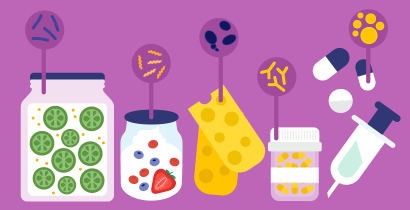What is the microbiome and why is it important?
Last Updated : 16 June 2021Microbiomes are everywhere in, on and all around us. They are an integral part of our food system and are present at almost every step of the food production. Despite the negative connotations, such as food safety issues and diseases which people often associate with bacteria and other microorganisms, microbiomes actually provide many benefits and are essential for nutritious, plentiful and delicious food.
1. Microbiome vs microbiota – what’s the difference?
Microorganisms, such as bacteria, archaea, fungi, algae or viruses are tiny organisms that can be found almost everywhere on this planet, from the glaciers of Antarctica to the deepest regions of the oceans, and also across the food system. They are often just known for the harm and dangers some of them can entail, such as food poisoning, anti-microbial resistance, or infectious diseases like the swine or bird flu. However, microorganisms have many beneficial and positive effects for our health and well-being, and they provide profound and essential services to the environment. An assembly of different microorganisms living together in a habitat, such as the human gut or the soil, is called microbiota. The term microbiome, on the other hand, describes a community of different microorganisms that occupies a particular environment, and also considers how the different microorganisms interact with each other and their surrounding environmental conditions.1
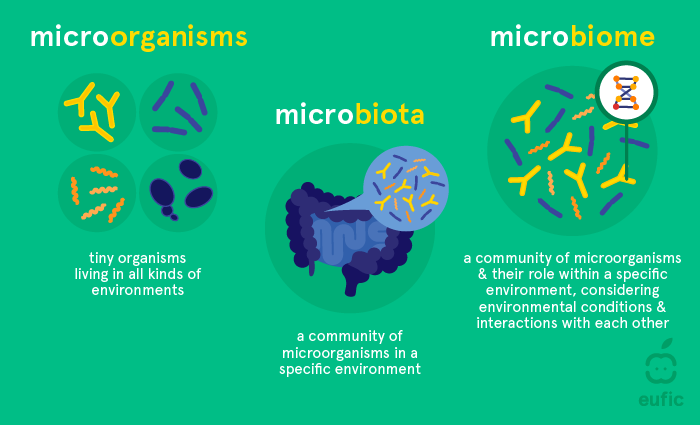
2. Uses of microorganisms
Microorganisms are used for a variety of purposes and applications and they provide many essential services, such as:
Health benefits
Often when people hear the word microbiome, they first think about the gut microbiome; which is understandable since the information about it is more widely spread and we hear most about it. There are roughly 40 trillion bacteria cells in the human body and the digestive tract is the place with the highest density of microorganisms.2 The gut bacteria help humans to digest food and they are closely tied to human immune health. They can be impacted by environmental factors and diet. Dietary components produced by or based on microorganisms, such as fermented foods and probiotics, can potentially support a healthy gut microbiome.3
The gut is not the only place where microorganisms can be found in the human body. Humans also have, for instance, vaginal, nasal, oral and skin microbiomes which have important roles in the maintenance of health.4 The total weight of the bacteria in our body is estimated to be up to 200 grams – composed just of tiny microorganisms.2
Environmental benefits
Microorganisms are an essential component of the ecosystem and they have a big impact on the environment we live in. A better understanding of the environmental microbiome might therefore be key to address societal challenges like climate change, because the impact of climate change depends heavily on the responses of microorganisms.5
Microbiomes contribute in various ways to healthy global ecosystems. Microorganisms in the ocean for example help storing carbon and they produce half of the oxygen we breath. In the soil some microorganisms support plant growth by fixing nutrients and decomposing organic matter.5 Furthermore, microorganisms can contribute to energy production by generating biogas and they are also used in the treatment of wastewater and the remediation of polluted sites.5,6
Medical purposes
Microorganisms also contribute to medical care and public health. They are for example used in the production of pharmaceuticals, like antibiotics and vaccines.6
Food production
Within the food system, microorganisms play an important role when it comes to the manufacturing and preservation of foods, e.g. yoghurt, pickles or kimchi.6 Microbiomes can also be found in many parts of the food system such as in livestock, fish, the soil and in and on crops, and they have the potential to reduce some of the negative environmental impacts of food waste by producing compost and recovering nutrients from it.4,7 In the next section we will dig deeper into the vital role microbiomes play in the food system.
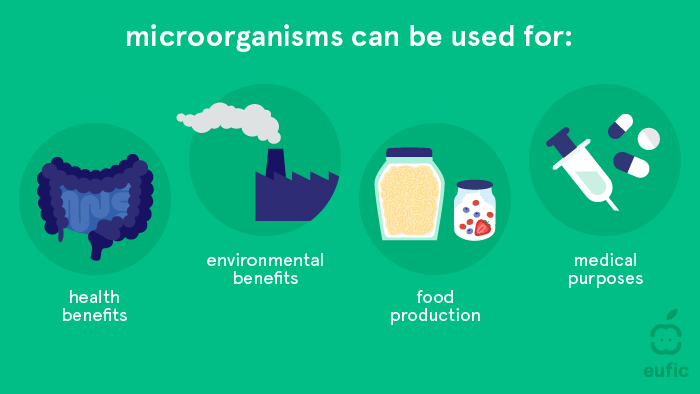
3. Microorganisms in food production
Microbiomes are present everywhere in the food system and microorganisms are used across the whole food chain. You can find beneficial but also not so beneficial microorganisms in all food production steps and environments:
Plant and soil
Soil, plants and their roots are constantly colonized by a diversity of microorganisms. Especially the region around the roots, also called rhizosphere, is a hot spot of microbial activity. The microorganisms in the rhizosphere usually come from the surrounding soil. These microorganisms support the plant to obtain nutrients and some can decrease the levels of stress hormones in a plant. However, some bacteria, if present in sufficient amounts and with the right environmental conditions, can also harm the plant and cause diseases. Farming practices, the type of plant, the plant’s genes and other environmental factors can influence the plant microbiome and its functioning. Researchers are currently working on developing inoculants of microorganisms (a.k.a. probiotics for the soil) that can be applied on the field to promote plant growth, stress resilience and the health of the crops.8
Aquatic and marine environment
Microorganisms make up a big part of marine life and because of their ability to fix nitrogen and carbon they also form the basis of the ocean’s food web.5 Photosynthetic algae and bacteria are the major components of marine phytoplankton and therefore the main food source for fish and other marine animals.6 Some microscopic algae however can produce toxic compounds and if fish and shellfish feed on these harmful algae, they can accumulate the toxins. If people are consuming those fish or shellfish they are ingesting the toxins too. This can have a negative impact on human health and lead to food poisoning.10 Microorganisms are present in the oceans in such large numbers and high diversity that scientists have so far only been able to characterize a small fraction of them.9
Animals
Animals have their own microbiome, such as in their gut or on their skin, which is equally or even more diverse than the human microbiome. The microorganisms help animals to take up nutrients, support their immune system and influence the health of the livestock.4
On the downside, certain bacteria that are present in a sufficient amount, can be pathogenic and cause infectious diseases in livestock production and aquaculture. To control and prevent their spread, antibiotics are used. However, overuse and improper use of antimicrobials can accelerate the development of bacteria with antimicrobial resistance. This is a major threat to public health as antimicrobial resistant bacteria are likely transmitted from the animal to humans through the animal sourced food that we eat.11
Fermentation of food
Microorganisms are used in the production of several foods such as yoghurt, cheese, soy sauce and pickles. The fermentation of foods preserves them longer and was historically used to prevent food from spoilage. Additionally, fermentation can also enhance the nutritional quality of the product.6 Did you know that microorganisms are also essential to produce chocolate and coffee? Without fermentation cocoa and coffee beans would not develop their distinct taste and flavour.
Food waste
Storing food for too long or under the wrong conditions may result in food starting to go rotten. Over time, as the amount of undesirable microorganisms grows, this can lead to food spoilage and other food safety issues, such as food poisoning.12 On the other hand, microorganisms can be beneficial in the recycling of our food waste. Through composting they contribute to recovering nutrients from the waste which can be applied back to the soil as biofertilizer.7
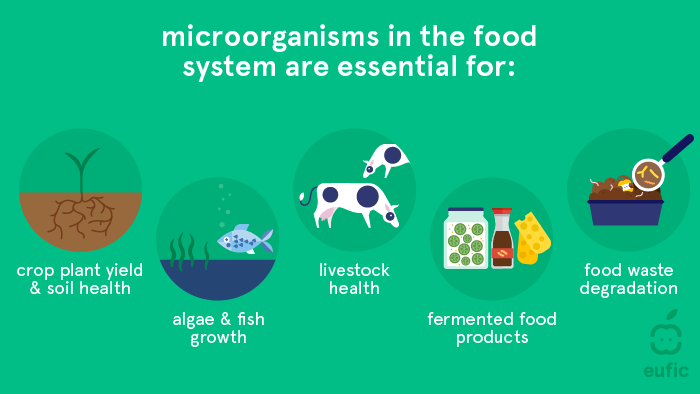
4. Outlook into the future
The microbiomes of soil, plant, animal, and marine ecosystems are key to environmental health and a food system which delivers highly nutritious, affordable, safe and sustainable food to us all. Research and innovation on microbiomes in the food system is constantly advancing. An increasing understanding of the microbiome in the food system will play an important role in providing healthy diets for everyone and shifting the current food system to a more sustainable one.13 The EU-funded project CIRCLES (Horizon 2020 grant agreement No 818290) for instance, investigates microbiome interactions and circulations across seven food chains (spinach, tomato, poultry, swine, Atlantic salmon, seabream aquaculture and marine fishes) to deliver new and more sustainable food applications and innovations. Some of the questions the project seeks to address are:
- Can we have probiotics for the soil to improve tomato and spinach growth?
- Does the microbiome from wild fishes affect the microbiome of fishes in aquaculture, and vice versa?
- Do microbiomes from farm animals (chickens and pigs) interact with the microbiomes of farm workers?
The project will be finished in 2024 and we hope to give you answers on some of these questions by then.

Takeaway message
Microorganisms are essential throughout the whole food production – from supporting crop growth to the composting of food waste.
References
- Berg G, et al. (2020). Microbiome definition re-visited: old concepts and new challenges. Microbiome 8 (103).
- Sender R, Fuchs S & Milo R (2016). Revised Estimates for the Number of Human and Bacteria Cells in the Body. PLoS Biology 14(8).
- Bell V, et al. (2018). One Health, Fermented Foods, and Gut Microbiota. Foods 7(12).
- Trinh P, et al. (2018). One Health Relationships Between Human, Animal, and Environmental Microbiomes: A Mini-Review. Frontiers in Public Health 6.
- Cavicchioli R, et al. (2019). Scientists’ warning to humanity: microorganisms and climate change. Nature Reviews Microbiology 6:569-586.
- Timmis K, et al. (2019). The urgent need for microbiology literacy in society. Environmental Microbiology 21 (5):1513-1528.
- Food and Agriculture Organization of the United Nations (FAO) (2019). The state of food and agriculture - moving forward on food loss and waste reduction. Rome, Italy: FAO.
- Compant S, et al. (2019). A review on the plant microbiome: Ecology, functions, and emerging trends in microbial application. Journal of Advanced Research 19:29-37.
- Atlantic Ocean Research Alliance (AORA) (2020). Marine Microbiome Roadmap.
- Berdalet E, et al. (2016). Marine harmful algal blooms, human health and wellbeing: challenges and opportunities in the 21st century. Journal of the Marine Biological Association of the United Kingdom 96(1):61-91.
- Food and Agriculture Organization of the United Nations (FAO) (2016). Drivers, dynamics and epidemiology of antimicrobial resistance in animal production. Rome, Italy: FAO.
- De Filippis F, Parente E & Ercolini D (2018). Recent Past, Present, and Future of the Food Microbiome. Annual Review of Food Science and Technology 9(1):589-608
- Malyska A, et al. (2019). The Microbiome: A Life Science Opportunity for Our Society and Our Planet. Trends in Biotechnology 37(12):1269-1272.

